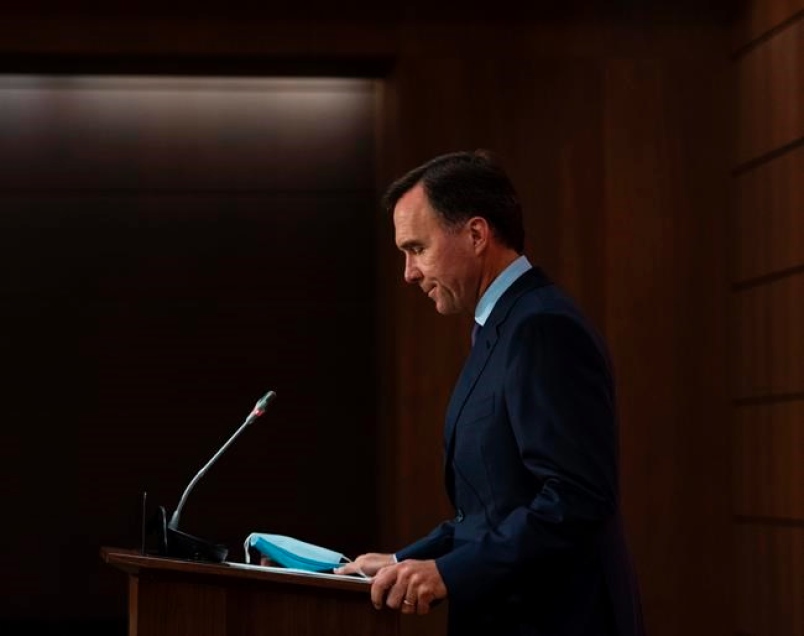Advertisement
The company said the ads would not be directed specifically to audiences based on their public voter records or political affiliations.

SAN FRANCISCO — Google will restrict how precisely political advertisers can target an audience on its online services, the company announced on Wednesday in a move that shook up the digital plans for campaigns during the 2020 presidential election.
Political advertisers will be able to aim their messages at people based on their age, gender or location. Google will also allow ads to be targeted to people based on the content of websites they visit. However, the ads can no longer be directed to specific audiences based on their public voter records or political affiliations categorized as “left-leaning,” “right-leaning,” or “independent,” the company said in a blog post.
The policy will apply to ads shown to users of Google’s search engine and YouTube, as well as display advertisements sold by the company that appear on other websites.
The decision left political strategists stunned and scrambling to react. Modern political campaigns have relied on the tools and data offered by technology giants like Google and Facebook, which dominate the online ad industry. The campaigns have been able to cater different messages for potential voters based on signals such as political leanings, what articles they have read, what videos they have watched and what things they have searched for.
Instead of blanketing an entire city with a costly TV spot, the so-called microtargeting of political ads has become controversial because it allows advertisers to seek out specific voters and perhaps avoid broader scrutiny of their messages.
“This will align our approach to election ads with long-established practices in media such as TV, radio and print, and result in election ads being more widely seen and available for public discussion,” wrote Scott Spencer, a vice president on Google’s ads team.
Tech companies face increased criticism over how they handle political speech, including advertisements. Mark Zuckerberg, the chief executive of Facebook, has been accused of amplifying disinformation, hate speech and violent content. But he has said he would not block political ads containing false statements, despite rising pressure, particularly from Democrats, to do so.
Last month, Twitter announced that it would prohibit all political ads from its service. Twitter’s move was largely seen as a response to the controversy caused by Facebook.
The debate about political ads was thrust into the spotlight after Facebook and Google did not take down a 30-second video ad from the Trump campaign that made a false claim about interactions with Ukraine involving Joseph R. Biden Jr., the former vice president and a Democratic presidential contender.
Brad Parscale, Mr. Trump’s campaign manager, lashed out on Twitter at Google for the policy change, accusing political elites and big tech of wanting to “rig the election” and said they “won’t stop until they control all digital political speech.” Earlier in the day, the Trump campaign also criticized Facebook in a tweet for considering changes to its political advertising policy, saying it “wants to take important tools away from us for 2020.”
Tom Channick, a Facebook spokesman, said the company was “looking at different ways we might refine our approach to political ads.”
Google said while it had never allowed any advertiser — including politicians — to make false assertions, it was clarifying its policy to explicitly ban ads that make “demonstrably false claims that could significantly undermine participation or trust” in the election process. Google noted, however, that it expects to take action on a “very limited” number of political ads. Michael Posner, a professor at New York University’s Stern School of Business, said Google’s policy change was a good start but did not go far enough in dealing with potential misinformation.
“It feels too much like a lawyer looking for language to give the company a lot of latitude,” Mr. Posner said.
Google said it would introduce the new policies within a week in Britain, ahead of the country’s general election, and then to the United States and the rest of the world in January, shortly before the Iowa caucuses. The company said the ad policy would include any candidates or officeholders of state or federal elected office.
In an email to campaigns, Google outlined the new rules in greater detail, including that election ads will no longer be allowed to target what is called “affinity audiences” that look like other groups that campaigns might want to target. Campaigns can also no longer upload their own lists of people to show ads.
In addition, there will be no more of what is known as “remarketing,” the process of serving ads to people who have previously taken an action like visiting a campaign’s website.
“It eliminates our ability to target based on any personal information,” said Danielle Butterfield, paid media director for Priorities USA, a leading Democratic super PAC that has announced plans to spend more than $100 million, much of it online.
Keegan Goudiss, a Democratic digital strategist, worried about the implications beyond campaigns. “We are quickly transitioning to a world where corporate communications is prioritized over anything deemed ‘political,’” he said. “That’s dangerous for democracy.”
Unhappiness was spread across both sides of the aisle.
Michael Duncan, a Republican digital strategist, called the announcement a “horrible” move that “that will hurt cash-strapped grass-roots campaigns,” which often rely on microtargeting to find success.
“They’re placating a mob that will never be satisfied & undermining the foundation of the Internet economy,” Mr. Duncan wrote on Twitter.
Daisuke Wakabayashi reported from San Francisco, and Shane Goldmacher from New York. Kate Conger contributed reporting from San Francisco.




